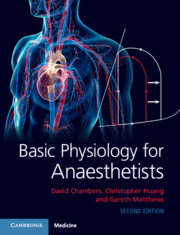Book contents
- Basic Physiology for Anaesthetists
- Basic Physiology for Anaesthetists
- Copyright page
- Dedication
- Contents
- Foreword
- Preface to the Second Edition
- Preface to the First Edition
- Abbreviations
- Section 1 The Basics
- Section 2 Respiratory Physiology
- Section 3 Cardiovascular Physiology
- Section 4 Neurophysiology
- Section 5 Gastrointestinal Tract
- Section 6 Kidney and Body Fluids
- Section 7 Blood and Immune System
- Section 8 Energy Balance
- Chapter 77 Metabolism
- Chapter 78 Starvation
- Chapter 79 Stress Response
- Section 9 Endocrine Physiology
- Section 10 Developmental Physiology
- Section 11 Environmental Physiology
- Index
- References
Chapter 79 - Stress Response
from Section 8 - Energy Balance
Published online by Cambridge University Press: 31 July 2019
- Basic Physiology for Anaesthetists
- Basic Physiology for Anaesthetists
- Copyright page
- Dedication
- Contents
- Foreword
- Preface to the Second Edition
- Preface to the First Edition
- Abbreviations
- Section 1 The Basics
- Section 2 Respiratory Physiology
- Section 3 Cardiovascular Physiology
- Section 4 Neurophysiology
- Section 5 Gastrointestinal Tract
- Section 6 Kidney and Body Fluids
- Section 7 Blood and Immune System
- Section 8 Energy Balance
- Chapter 77 Metabolism
- Chapter 78 Starvation
- Chapter 79 Stress Response
- Section 9 Endocrine Physiology
- Section 10 Developmental Physiology
- Section 11 Environmental Physiology
- Index
- References
Summary
The stress response is a complex neuroendocrine response to physiological stress. The most commonly encountered stressors are trauma, burns, surgery and critical illness; the magnitude of the neuroendocrine response is directly related to the magnitude of the stressor. In addition to its metabolic effects, the stress response leads to activation of the immunological and haematological systems.
- Type
- Chapter
- Information
- Basic Physiology for Anaesthetists , pp. 387 - 390Publisher: Cambridge University PressPrint publication year: 2019

